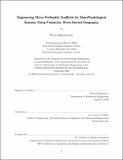Engineering micro-perfusable scaffolds for MesoPhysiological Systems using projection Micro-StereoLithography
Author(s)
Sphabmixay, Pierre.
Download1227108322-MIT.pdf (7.166Mb)
Other Contributors
Massachusetts Institute of Technology. Department of Mechanical Engineering.
Advisor
Linda G. Griffith.
Terms of use
Metadata
Show full item recordAbstract
MicroPhysiological Systems (MPS) are in vitro models that capture the complexity of human organs at miniature scale by recreating the native microenvironment of resident cells. These systems offer promising alternatives to in vivo animal models for the development of new drugs, disease modeling and biological research. The organs in the human body are continuously perfused via a dense network of blood vessels delivering oxygen, nutrients and biomolecules locally while clearing waste materials produced by the tissue. As a result, MPS that incorporate microperfusion in a three-dimensional format have been a major focal point in the community driving major efforts towards in vitro vascularization methods. A major obstacle to the development of these MPS was the micrometric scale of the human cells forming the building block of any biological system. But advances in micro and nanofabrication techniques have led to the creation of a myriad of new MPS that allow the successful culture of 3D tissues under microperfusion. Nevertheless, the translation of in vitro data from MPS to clinical data is confronted with the fundamental problem arising from the multi-dimensional scaling of experimental parameters, from micrometric systems to macroscale organs. This thesis describes the design, fabrication and implementation of a MesoPhysiological System (MePS) for the culture of human cells at mescoscopic scale. The MePS consists of a perfusable 3D printed network of microcapillaries serving as a scaffold for the tissue with built-in vasculature. The manufacturing of the MePS was performed using a Projection Micro-StereoLithography Apparatus which enabled the fabrication of centimetric scaffolds with micrometric features at high through-put. The geometry of the MePS was carefully designed using computational fluid dynamics and computational model of oxygen transport so that critical physico-chemical parameters of the MePS, such as shear forces and oxygen levels would reach physiological values. Long term cultures of liver and brain tissues were performed in the MePS and featured elevated function and viability compared to other MPS. The increased metabolic rate and hepatic function of the liver MePS permitted to recapitulate critical features of metabolic disorders, such as chronic development of an insulin resistance phenotype in type 2 diabetes mellitus.
Description
Thesis: Ph. D., Massachusetts Institute of Technology, Department of Mechanical Engineering, 2020 Cataloged from student-submitted PDF of thesis. Includes bibliographical references (pages 140-155).
Date issued
2020Department
Massachusetts Institute of Technology. Department of Mechanical EngineeringPublisher
Massachusetts Institute of Technology
Keywords
Mechanical Engineering.